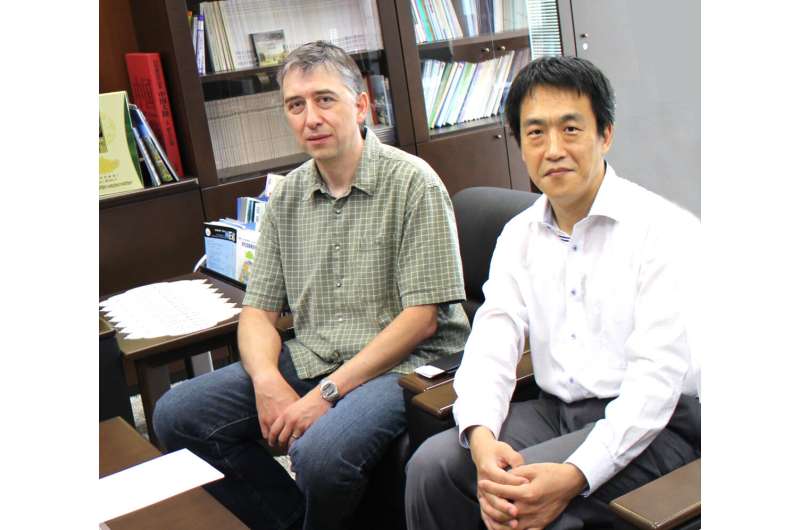Analyzing seismic patterns to forecast the magnitude of the largest earthquake aftershocks

Earthquakes can have devastating impacts on communities all around the world. They strike without warning, often resulting in large fatalities. Since the aftershocks that follow the initial earthquake often prove to be more catastrophic than the mainshock, being able to accurately predict the intensity of future aftershocks can help to save lives. Associate Professor Jiancang Zhuang and Emeritus Professor Yosihiko Ogata from The Institute of Statistical Mathematics (ISM) in Japan, in collaboration with colleagues, have developed a method that can forecast the probability of when and where aftershocks are likely to occur, and how strong the largest of these will be.
Their findings were published on September 6th, 2019 in Nature Communications.
Earthquakes can trigger movement within the Earth's crust, causing instability that can result in more powerful tremors. An earthquake is seldom an isolated event, but rather accompanied with a sequence of events, often referred to as clusters. Each sequence is typically dominated by an event that has a larger magnitude than all the other events within the sequence. This event is known as the mainshock, while the events that precede and/or follow are known as foreshocks and aftershocks respectively. Aftershocks occur in the same region as the mainshock but are of smaller magnitude. When an aftershock is larger than the mainshock, the original mainshock is redesignated as a foreshock, and the larger aftershock is recognized as the mainshock.
"Many strong earthquakes are followed by a subsequent large earthquake, of magnitude similar to the initial quake or even stronger. Repeating earthquakes cause accumulated damage on already weakened buildings and infrastructures; therefore, forecasting their occurrence is a challenging task from the viewpoint of civil protection to prevent the continuous loss of lives," said the authors. "The probabilities of the largest earthquake following a large earthquake can be evaluated by learning from other earthquake sequences—a statistical method known as Bayesian inference—and from a very short record of the earthquake sequence," Zhuang explained.
The authors have introduced a new method for predicting the magnitude of the largest aftershock within a future time interval, in real-time, from the history of the earthquake sequence. This method analyzes the data patterns from the particular earthquake by combining two statistical methods (Bayesian statistics and extreme value theory) and incorporating the data into the Epidemic Type Aftershock-Sequence (ETAS) model—a point process representing the time-related activity of earthquakes in a certain geophysical region—in order to quickly and accurately compute and forecast the probability and severity of aftershocks. The method, which was successfully used to analyze the earthquake sequences from the 2016 earthquake in Kumamoto, Japan, and retrospectively predicted the likelihood of large subsequent earthquakes following the mainshock, provides a useful tool for mitigating earthquake hazard.
"We understand that it is impossible to make precise predictions of when and where a damaging earthquake will occur due to the inherent randomness in earthquake occurrence and our limited observations of the underground process. But earthquake occurrence is not completely random either," said Zhuang. "This work is done by making use of our understanding of earthquake clustering, which is the most predictable component in seismicity. Our goal is to find as many predictable components in the earthquake process as possible so that we can reduce the randomness in our forecasts."
This research follows on from a related research result co-authored by Ogata that was published in Scientific Reports in 2013, which used the Omori formula to forecast large aftershocks within one day after the main shock.
"The difference between the two papers," says Zhuang, "is that the former is based on the Omori formula, which only applies in the case of a single mainshock, and implies the frequency of aftershocks decreases quickly with time. Whereas our paper is based on the ETAS model, a more advanced model that applies to multiple major earthquakes, such as in the Kumamoto case," he said. "The model used in the 2013 study aims to correct the biases caused by missing data, while the new model helps to obtain stable results as quickly as possible by using prior knowledge."
Furthermore, the model described in the 2013 paper "forecasts the rate of earthquake in the future, and only considers the largest magnitude in a fixed time interval in the future," said Zhuang, adding: "The results of the two papers compensate each other rather than conflict one another. It is difficult to compare them directly through their outputs."
"One of the important advantages of the implemented method is that it fully incorporates the uncertainties of the model parameters into the analysis and the clustering structure of seismicity," the authors write, concluding that "complex triggering including foreshocks and/or higher-order aftershocks cannot be neglected for purposes of earthquake/aftershock forecasting."
According to Zhuang, the next step is to be able to compute this in real-time, so that once the record of earthquakes is updated, the probability forecast is updated immediately.
More information: Robert Shcherbakov et al, Forecasting the magnitude of the largest expected earthquake, Nature Communications (2019). DOI: 10.1038/s41467-019-11958-4
Journal information: Scientific Reports , Nature Communications
Provided by Research Organization of Information and Systems

















